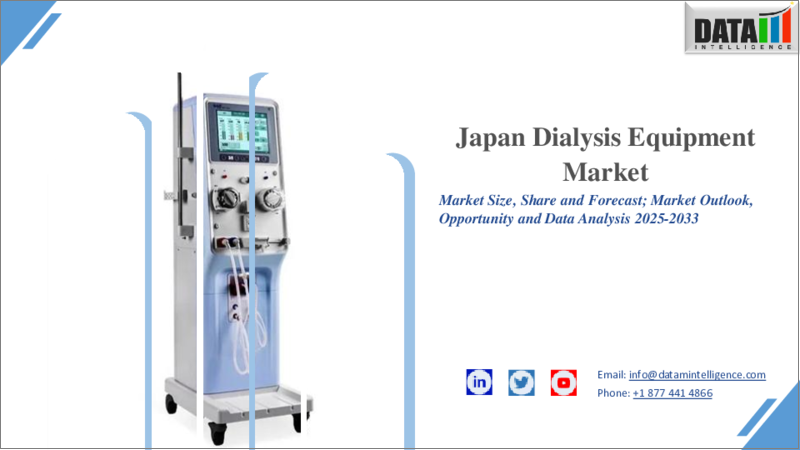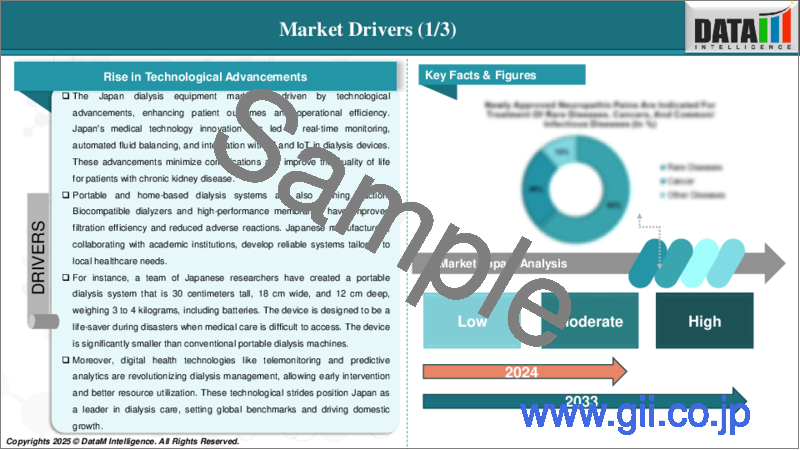|
|
市場調査レポート
商品コード
1606496
日本の透析装置市場-2024~2031年Japan Dialysis Equipment Market - 2024-2031 |
||||||
カスタマイズ可能
適宜更新あり
|
|||||||
| 日本の透析装置市場-2024~2031年 |
|
出版日: 2024年12月04日
発行: DataM Intelligence
ページ情報: 英文 184 Pages
納期: 即日から翌営業日
|
- 全表示
- 概要
- 目次
概要
日本の透析装置市場は、2023年に28億米ドルに達し、2031年には40億6,000万米ドルに達すると予測され、予測期間2024-2031年のCAGRは4.5%で成長します。
透析装置は、血液透析の際に血液を濾過し、電解質バランスと体温を維持する医療機器です。透析装置は、血液から老廃物を除去し、電解質とミネラルを適切なレベルに維持する透析液と呼ばれる液体を混合し、監視する装置です。また、体外の血流をモニターし、必要なチェックをユーザーに知らせるためにアラームを鳴らすこともあります。
市場力学:
促進要因と阻害要因
技術の進歩
日本の透析装置市場は、技術的進歩、患者の転帰向上、業務効率化によって牽引されています。日本の医療技術革新は、透析装置のリアルタイムモニタリング、自動体液バランス、AIやIoTとの統合につながっています。これらの進歩は合併症を最小限に抑え、慢性腎臓病患者の生活の質を向上させる。
ポータブル透析システムや在宅透析システムも人気を集めています。生体適合性ダイアライザーと高性能膜は、ろ過効率を向上させ、副作用を減少させました。日本のメーカーは学術機関と協力し、地域のヘルスケアニーズに合わせた信頼性の高いシステムを開発しています。
例えば、日本の研究チームは、高さ30センチ、幅18センチ、奥行き12センチ、重さ3~4キログラム(電池を含む)のポータブル透析システムを開発しました。この装置は、医療へのアクセスが困難な災害時の救命装置として設計されています。従来のポータブル透析装置よりも大幅に小型化されています。
さらに、遠隔監視や予測分析などのデジタルヘルス技術は、透析管理に革命をもたらし、早期介入とより良い資源利用を可能にしています。このような技術的進歩により、日本は透析医療のリーダーとしての地位を確立し、世界の基準を設定し、国内の成長を牽引しています。
高額な機器コスト
日本の透析装置市場は、高度なヘルスケア・インフラと腎ケア・サービスへの高い需要があるにもかかわらず、機器の高コストによる大きな抑制要因に直面しています。初期投資と継続的なメンテナンス費用は、ヘルスケアプロバイダー、特に小規模クリニックや地方の施設にとって財政的課題となります。日本の国民皆保険制度と診療報酬政策は患者の経済的負担をいくらか軽減するが、運営費は依然として障壁です。費用対効果の高い技術革新、政府からの補助金、またはパートナーシップによってこの市場抑制要因に対処することで、日本の透析セクターにおけるより広いアクセシビリティと市場成長を確保できる可能性があります。
例えば、ニプロの透析装置は、腎臓で血液を浄化できない場合に血液をろ過するために病院、診療所、診断センターで使用される医療機器です。インドの平均価格は1,223,995~1,500,000円(日本円)で、機械のタイプ、処理能力、容量、高度な機能、付属品、モデルによって異なります。これらの機械は、病院の店舗からオンラインで購入することができます。
目次
第1章 調査手法と調査範囲
第2章 定義と概要
第3章 エグゼクティブサマリー
第4章 市場力学
- 影響要因
- 促進要因
- 技術進歩の高まり
- 促進要因
- 抑制要因
- 機器の高コスト
- 機会
- 影響分析
第5章 産業分析
- ポーターのファイブフォース分析
- サプライチェーン分析
- 価格分析
- 規制分析
第6章 製品タイプ別
- 血液透析装置
- 腹膜透析装置
- その他
第7章 病状別
- 慢性
- 急性
第8章 エンドユーザー別
- 病院
- クリニック
- 透析センター
- 外来手術センター
- ホームケア設定
第9章 競合情勢
- 競合シナリオ
- 市況・シェア分析
- M&A分析
第10章 企業プロファイル
- Nikkiso Co., Ltd.
- 会社概要
- 製品ポートフォリオと概要
- 財務概要
- 主な発展
- Fresenius Medical Care Japan K.K.
- Kawasumi Laboratories, Inc.
- Asahi Kasei Medical Co., Ltd.
- Toray Medical Co., Ltd.
- Terumo Corporation
- Nipro Corporation
- JMS Co., Ltd.
第13章 付録
Overview
The Japan dialysis equipment market reached US$ 2.8 billion in 2023 and is expected to reach US$ 4.06 billion by 2031, growing at a CAGR of 4.5% during the forecast period 2024-2031.
A dialysis machine is a medical device that filters blood during hemodialysis procedures, maintaining electrolyte balance and temperature. The dialysis machine is a device that mixes and monitors the fluid called dialysate, which removes waste products from the blood and maintains proper levels of electrolytes and minerals. It also monitors blood flow outside the body and may sound an alarm to alert the user of any necessary checks.
Market Dynamics: Drivers & Restraints
Rise in the Technological Advancements
The Japan dialysis equipment market is driven by technological advancements, enhancing patient outcomes and operational efficiency. Japan's medical technology innovation has led to real-time monitoring, automated fluid balancing, and integration with AI and IoT in dialysis devices. These advancements minimize complications and improve the quality of life for patients with chronic kidney disease.
Portable and home-based dialysis systems are also gaining traction. Biocompatible dialyzers and high-performance membranes have improved filtration efficiency and reduced adverse reactions. Japanese manufacturers, collaborating with academic institutions, develop reliable systems tailored to local healthcare needs.
For instance, a team of Japanese researchers have created a portable dialysis system that is 30 centimeters tall, 18 cm wide, and 12 cm deep, weighing 3 to 4 kilograms, including batteries. The device is designed to be a life-saver during disasters when medical care is difficult to access. The device is significantly smaller than conventional portable dialysis machines.
Moreover, digital health technologies like telemonitoring and predictive analytics are revolutionizing dialysis management, allowing early intervention and better resource utilization. These technological strides position Japan as a leader in dialysis care, setting global benchmarks and driving domestic growth.
High Cost of the Equipment
Japan's dialysis equipment market faces significant restraint due to the high cost of equipment, despite the country's advanced healthcare infrastructure and high demand for renal care services. Initial investments and ongoing maintenance expenses pose financial challenges for healthcare providers, especially smaller clinics and rural facilities. Japan's universal healthcare system and reimbursement policies alleviate some financial strain for patients, but operational expenses remain a barrier. Addressing this restraint through cost-effective innovations, government subsidies, or partnerships could ensure broader accessibility and market growth in Japan's dialysis sector.
For instance, A Nipro dialysis machine is a medical device used in hospitals, clinics, and diagnostic centers to filter blood when kidneys cannot purify it. The average price in India is between 1223995-1500000 Japan Yen, depending on machine type, throughput, capacity, advanced features, accessories, and models. These machines can be purchased online from hospital stores.
Segment Analysis
The Japan dialysis equipment market is segmented based on product type, disease condition and end user.
Product Type:
Hemodialysis Devices segment is expected to dominate the dialysis equipment market share
The hemodialysis devices segment holds a major portion of the dialysis equipment market share and is expected to continue to hold a significant portion of the dialysis equipment market share during the forecast period.
Japan has seen a significant growth in the end-stage renal disease hemodialysis devices market due to innovative dialyzing systems. The country has one of the highest per capita dialysis patients globally, emphasizing the importance of efficient devices for the elderly population. Hemodialysis devices help patients clean blood from harmful substances like toxins, waste, and excess water due to kidney failure.
The Japan market is characterized by high-tech machines with accuracy, reliability, and patient safety. Advancements in real-time monitoring, automatic functions, and easy navigation have driven the adoption of hemodialysis equipment. Local players understand local market demands, dominating the market, while international players bring better technologies and quality. The use of AI and IoT devices in hemodialysis machines is also increasing due to improved treatment protocols and results. Government policies and reimbursement systems also contribute to the market for hemodialysis devices in Japan.
Hospitals segment is the fastest-growing segment in the dialysis equipment market share
The hospitals segment is the fastest-growing segment in the dialysis equipment market share and is expected to hold the market share over the forecast period.
Japan's hospitals are key providers of hemodialysis services, offering comprehensive services like patient monitoring, emergency care, and individualized treatment plans. With a universal healthcare system and specialized nephrology departments, hospitals are central to delivering dialysis treatments to the growing patient population.
They provide state-of-the-art equipment, support cutting-edge technologies, and facilitate research and clinical trials. Japan's hospitals maintain rigorous standards for infection control and patient safety, ensuring the dialysis process adheres to the highest quality benchmarks. Urban hospitals house larger dialysis centers, while rural hospitals work towards expanding accessibility. Government funding and insurance coverage encourage patients to seek care from these well-equipped facilities. As chronic kidney disease burdens rise, hospitals will continue to drive the growth and evolution of the dialysis equipment market in Japan.
Competitive Landscape
The major Japan players in the dialysis equipment market include T Nikkiso Co., Ltd, Fresenius Medical Care Japan K.K, Kawasumi Laboratories, Inc, Asahi Kasei Medical Co., Ltd., Toray Medical Co., Ltd., Terumo Corporation,Nipro Corporation, JMS Co., Ltd among others.
Emerging Players
The emerging players in the dialysis equipment market include Medikit Co., Ltd, Sanritsu Corporation, Hitachi Healthcare Systems, Kyowa Hakko Kirin Co., Ltd and among others.
Key Developments
- In September 2022, WEGO Terumo, a joint venture between WEGO and Terumo, has received regulatory approval from the National Medical Products Administration to manufacture and market a new neutral peritoneal dialysis solution.
Why Purchase the Report?
- To visualize the Japan dialysis equipment market segmentation based on product type, disease condition, end user and understand key commercial assets and players.
- Identify commercial opportunities by analyzing trends and co-development.
- Excel data sheet with numerous data points of the dialysis equipment market with all segments.
- PDF report consists of a comprehensive analysis after exhaustive qualitative interviews and an in-depth study.
- Product mapping is available in excel consisting of key products of all the major players.
The Japan dialysis equipment market report would provide approximately 70 tables, 65 figures, and 184 pages.
Target Audience 2023
- Manufacturers/ Buyers
- Industry Investors/Investment Bankers
- Research Professionals
- Emerging Companies
Table of Contents
1. Methodology and Scope
- 1.1. Research Methodology
- 1.2. Research Objective and Scope of the Report
2. Definition and Overview
3. Executive Summary
- 3.1. Snippet by Product Type
- 3.2. Snippet by Disease Condition
- 3.3. Snippet by End User
4. Dynamics
- 4.1. Impacting Factors
- 4.1.1. Drivers
- 4.1.1.1. Rise in the Technological Advancements
- 4.1.1. Drivers
- 4.2. Restraints
- 4.2.1.1. High Cost of the Equipment
- 4.3. Opportunity
- 4.3.1. Impact Analysis
5. Industry Analysis
- 5.1. Porter's Five Force Analysis
- 5.2. Supply Chain Analysis
- 5.3. Pricing Analysis
- 5.4. Regulatory Analysis
6. By Product Type
- 6.1. Introduction
- 6.1.1. Market Size Analysis and Y-o-Y Growth Analysis (%), By Product Type
- 6.1.2. Market Attractiveness Index, By Product Type
- 6.2. Hemodialysis Devices*
- 6.2.1. Introduction
- 6.2.2. Market Size Analysis and Y-o-Y Growth Analysis (%)
- 6.3. Peritoneal Dialysis Devices
- 6.4. Others
7. By Disease Condition
- 7.1. Introduction
- 7.1.1. Market Size Analysis and Y-o-Y Growth Analysis (%), By Disease Condition
- 7.1.2. Market Attractiveness Index, By Disease Condition
- 7.2. Chronic*
- 7.2.1. Introduction
- 7.2.2. Market Size Analysis and Y-o-Y Growth Analysis (%)
- 7.3. Acute
8. By End User
- 8.1. Introduction
- 8.1.1. Market Size Analysis and Y-o-Y Growth Analysis (%), By End User
- 8.1.2. Market Attractiveness Index, By End User
- 8.2. Hospitals*
- 8.2.1. Introduction
- 8.2.2. Market Size Analysis and Y-o-Y Growth Analysis (%)
- 8.3. Clinics
- 8.4. Dialysis Centers
- 8.5. Ambulatory Surgical Centers
- 8.6. Homecare Settings
9. Competitive Landscape
- 9.1. Competitive Scenario
- 9.2. Market Positioning/Share Analysis
- 9.3. Mergers and Acquisitions Analysis
10. Company Profiles
- 10.1. Nikkiso Co., Ltd.*
- 10.1.1. Company Overview
- 10.1.2. Product Portfolio and Description
- 10.1.3. Financial Overview
- 10.1.4. Key Developments
- 10.2. Fresenius Medical Care Japan K.K.
- 10.3. Kawasumi Laboratories, Inc.
- 10.4. Asahi Kasei Medical Co., Ltd.
- 10.5. Toray Medical Co., Ltd.
- 10.6. Terumo Corporation
- 10.7. Nipro Corporation
- 10.8. JMS Co., Ltd.
LIST NOT EXHAUSTIVE
13. Appendix
- 13.1 About Us and Services
- 13.2 Contact Us






